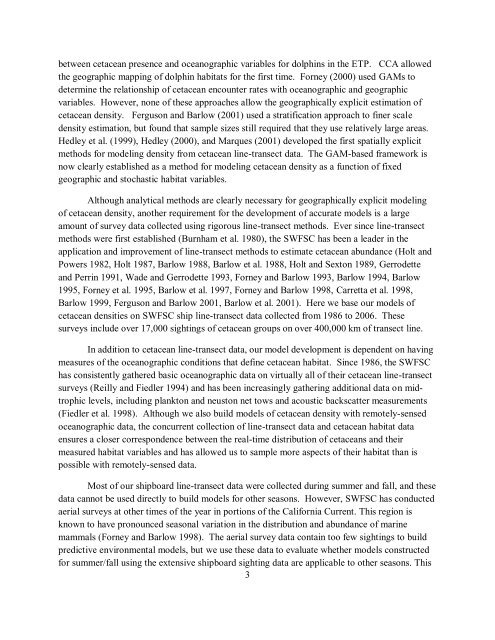Final Technical Report: - Southwest Fisheries Science Center - NOAA
Final Technical Report: - Southwest Fisheries Science Center - NOAA
Final Technical Report: - Southwest Fisheries Science Center - NOAA
Create successful ePaper yourself
Turn your PDF publications into a flip-book with our unique Google optimized e-Paper software.
etween cetacean presence and oceanographic variables for dolphins in the ETP. CCA allowed<br />
the geographic mapping of dolphin habitats for the first time. Forney (2000) used GAMs to<br />
determine the relationship of cetacean encounter rates with oceanographic and geographic<br />
variables. However, none of these approaches allow the geographically explicit estimation of<br />
cetacean density. Ferguson and Barlow (2001) used a stratification approach to finer scale<br />
density estimation, but found that sample sizes still required that they use relatively large areas.<br />
Hedley et al. (1999), Hedley (2000), and Marques (2001) developed the first spatially explicit<br />
methods for modeling density from cetacean line-transect data. The GAM-based framework is<br />
now clearly established as a method for modeling cetacean density as a function of fixed<br />
geographic and stochastic habitat variables.<br />
Although analytical methods are clearly necessary for geographically explicit modeling<br />
of cetacean density, another requirement for the development of accurate models is a large<br />
amount of survey data collected using rigorous line-transect methods. Ever since line-transect<br />
methods were first established (Burnham et al. 1980), the SWFSC has been a leader in the<br />
application and improvement of line-transect methods to estimate cetacean abundance (Holt and<br />
Powers 1982, Holt 1987, Barlow 1988, Barlow et al. 1988, Holt and Sexton 1989, Gerrodette<br />
and Perrin 1991, Wade and Gerrodette 1993, Forney and Barlow 1993, Barlow 1994, Barlow<br />
1995, Forney et al. 1995, Barlow et al. 1997, Forney and Barlow 1998, Carretta et al. 1998,<br />
Barlow 1999, Ferguson and Barlow 2001, Barlow et al. 2001). Here we base our models of<br />
cetacean densities on SWFSC ship line-transect data collected from 1986 to 2006. These<br />
surveys include over 17,000 sightings of cetacean groups on over 400,000 km of transect line.<br />
In addition to cetacean line-transect data, our model development is dependent on having<br />
measures of the oceanographic conditions that define cetacean habitat. Since 1986, the SWFSC<br />
has consistently gathered basic oceanographic data on virtually all of their cetacean line-transect<br />
surveys (Reilly and Fiedler 1994) and has been increasingly gathering additional data on midtrophic<br />
levels, including plankton and neuston net tows and acoustic backscatter measurements<br />
(Fiedler et al. 1998). Although we also build models of cetacean density with remotely-sensed<br />
oceanographic data, the concurrent collection of line-transect data and cetacean habitat data<br />
ensures a closer correspondence between the real-time distribution of cetaceans and their<br />
measured habitat variables and has allowed us to sample more aspects of their habitat than is<br />
possible with remotely-sensed data.<br />
Most of our shipboard line-transect data were collected during summer and fall, and these<br />
data cannot be used directly to build models for other seasons. However, SWFSC has conducted<br />
aerial surveys at other times of the year in portions of the California Current. This region is<br />
known to have pronounced seasonal variation in the distribution and abundance of marine<br />
mammals (Forney and Barlow 1998). The aerial survey data contain too few sightings to build<br />
predictive environmental models, but we use these data to evaluate whether models constructed<br />
for summer/fall using the extensive shipboard sighting data are applicable to other seasons. This<br />
3









